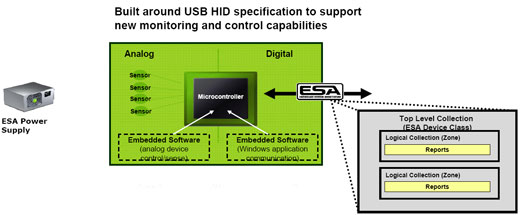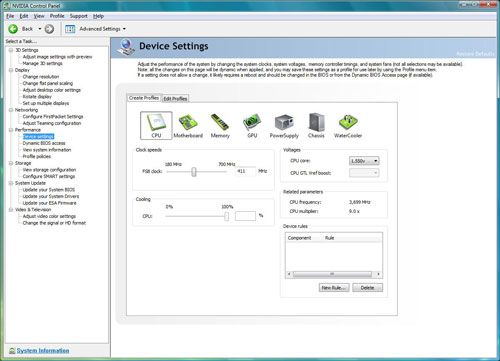Control Panel
As detailed in the ESA launch article, ESA is not a new control bus. It is built around the UBS HID specification. This means ESA sits on top of the existing USB specification to support new monitoring and control features. Other software is already sitting on top of USB, so ESA is fortunately not breaking any new ground in how it works. The standards already exist and the ESA specification has recently been approved by the USB-if HID subcommittee.
 |
ESA is both a hardware and software interface. Components that report ESA data and allow control must be ESA compliant. The software that reports and controls ESA components can be written for an OS, implemented in BIOS, or designed to operate before an OS - or any combinations of all three approaches. For those familiar with USB HID it is OS independent, operating before the OS loads, and thus ESA can eventually be OS independent.
Software ties ESA together, and while ESA is technically OS independent, our ESA test system supports ESA in software that is running in Windows Vista Ultimate or another Windows OS. NVIDIA System Monitor provides data on how the system is performing in temperature, FSB, voltages, fan speeds, overclocking, and whatever variable manufacturers choose to implement . NVIDIA Control Panel is where the end user can adjust these variables.
 |
ESA compliant power supplies, cases, water coolers, and many other component classes are controlled by NVIDIA Control Panel. On an ESA system, the available ESA components can be selected under "Performance", "Device Settings". In this example you can see the CPU has been adjusted to an FSB of 411 and voltage raised to 1.55V, resulting in an overclock of the 3.0GHz CPU to 3.7GHz.
To be perfectly frank the control aspects of ESA are not quite ready for prime time as it is not possible to dial-in the settings shown here without creating a blue screen and system crash. We had to first set the BIOS somewhere in the neighborhood of where we wanted to go and then do final tweaking with NVIDIA Performance in Control Panel.
Using Control Panel only, we were not able to overclock beyond an FSB of 366 without crashing the system. To be fair, NVIDIA made it very clear that the current test system was put together to demonstrate the monitoring capabilities of ESA with no real finalizing of performance tweaking in ESA. We were able to validate to our satisfaction that the current ESA interface does not appear to hamper the system's overclocking abilities as a whole - it was just not possible to exert full control of overclocking adjustments with the current ESA interface.
In recent conversations, NVIDIA has been emphatic that the released 780 and 790 ESA versions will provide the same overclocking capabilities with ESA that can be achieved in the BIOS. We certainly agree with that position and believe achieving this goal is critical to the success of ESA. As soon as these new ESA-updated components are available, AnandTech will be doing an article on overclocking and performance tweaking with ESA, and then we'll see if they can actually reach this objective.










19 Comments
View All Comments
cdl1701 - Friday, February 22, 2008 - link
Should there be pics in this write up? I am not seeing anyinitialised - Wednesday, February 20, 2008 - link
But using this to implement closed loop control for your overclocking and cooling setup is taking things to another level. e.g. Twc -> 1C fans -> 100RPM & Pump -> 10lph or Tcpu -> 1C Vtec -> 0.2V or more radical fps < 30 & fcore/fmem/fshader=stable, fcore/fmem/fshader -> 25MHz fan -> 10%.Most PC cooling is either crude or expensive. An OS independent control system like this with true dynamic control of BIOS CPU and Memory and GPU settings and cooling would be fantastic and could be done if crashes due to overheating/clocking can be handled before windows BSOD's. Needs a graphic (LabVIEW style) interface and low overhead though.
Hopefully it can be retrofitted to older motherboards and graphics cards with BIOS/driver updates.
Tristesse27 - Wednesday, February 20, 2008 - link
"To be fair, NVIDIA made it very clear that the current test system was put together to demonstrate the monitoring capabilities of ESA with no real finalizing of performance tweaking in ESA."Then to be perfectly fair, why would you even mention that it crashed when you try to tweak through the OS? They told you it wouldn't work, and it doesn't. I bet when the waiter tells you the plate is hot, you put your hand right on it, don't you?
stevekgoodwin - Tuesday, February 19, 2008 - link
So... turns out SMART has been subverted by various HDD manufacturers to misreport problems (because problems that might hurt sales). Which pretty much makes SMART useless.What's to stop this going the same way? There's no guarantee components are not distorting/faking results.
It'll be an interesting one to watch.
Kevin Day - Tuesday, February 19, 2008 - link
Could you imagine the kind of information you could gather on your corporate machines if someone wrote a plugin for say System Center Operations Manager? You could monitor client health not only from an applications perspective, but from the hardware as well. You could, for instance, detect a power supply that was having voltage fluctuations and replace it BEFORE it fails saving the user much down time.IKeelU - Tuesday, February 19, 2008 - link
Sorry if this has been address before, but will ESA interfaces be available for hardware that is not related to nVidia (e.g. intel chipsets, etc...)? It would be great to have a relatively consistent interface between manufacturers, similar to what a BIOS is now. If not, then I will definitely be swayed to the nVidia mobo camp. Being able to change profiles without going into the bios is going to be awesome. It's not like I need my C2D running on max overclock to use uTorrent or MS Word.Is there any chance of AMD adopting this? Does the spider platform cover most of what ESA does?
Wesley Fink - Wednesday, February 20, 2008 - link
NVidia is not charging licensing fees for ESA and the USB standard, with ESA approved to sit on top of that standard, is an Open Standard. Anyone who wishes could use ESA, and there don't appear to be unsurmountable artificial barriers to any computer manufacturer using ESA technology.LSnK - Tuesday, February 19, 2008 - link
"This begs the question of whether ESA is working now."Raises the question. Begging the question is the name of a logical fallacy wherein one assumes to be true that which they're supposed to be arguing.
Wesley Fink - Wednesday, February 20, 2008 - link
"Begs the question" expresses my thoughts.Slaimus - Tuesday, February 19, 2008 - link
Isn't there already a much more well established ESA, the Entertainment Software Association?